 Welcome to the Computer Vision and Multimedia Lab website.
Welcome to the Computer Vision and Multimedia Lab website.
GET IN TOUCH
Technological innovation for digital humanities
6 marzo 2018
Collegio Ghislieri, Piazza Ghislieri 5 - Pavia
Foto
(per ingrandire cliccare sull'immagine)
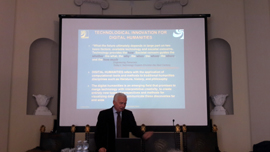
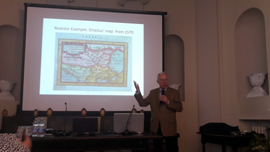
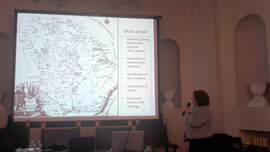
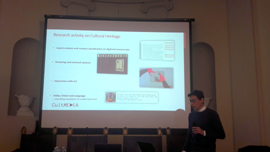
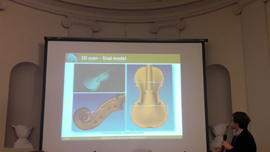
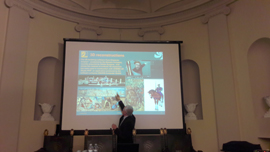
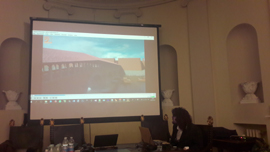
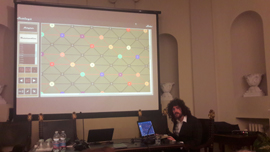
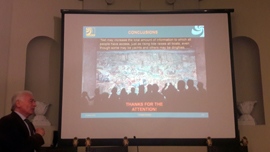
Abstracts
Vagueness and precision of historical objects in DH
Walther von Hahn, Hamburg University
Digital Humanities (DH) not only aims at archiving and presenting material (particularly historical artefacts), but also at introducing deeper scientific reflexion in humanities by a propagation of computational methods. However, more than ten years of computer-aided research did not lead to an adequate digital modelling of historical objects in a proper hermeneutic sense. In most DH-attempts the main cruces remain: 1. the storage of objects in database architectures designed for business or natural science applications, 2. the annotation by only very general metadata, 3. mark-up with merely shallow and local linguistic information, 4. a missing quantitative and inferential analysis. Consequently images and texts become artificially precise and the mutual illumination of texts and other media loses its traditional hermeneutic power. Because of these drawbacks many researchers in humanities still investigate digital objects with rather traditional methods. A paradigm change in modelling and representation of objects with the characteristics of humanities' research is urgently needed. In this talk I will present current research of our group aiming at modelling vagueness and uncertainty in a way that keeps historical categories and the potential of explanatory relations among media.Bio sketch. Walther von Hahn studied in Marburg/Lahn and received his PhD in 1968 in linguistics. After moving to Hamburg he engaged in Artificial Intelligence and was appointed full professor in Computer Science at Hamburg University. In 1984 he was honoured with the highest German research award by the Association for the Promotion of Science and Humanities. He was awarded the title of honorary professor of the University of Iași and the University of Bucharest.
A machine-aided investigation of reliability of historical facts in 18th century documents
Cristina Vertan, Hamburg University
Dimitrie Cantemir was one of the most prominent figures at the end of XVIIth and beginning of the XVIIIth century in the cultural space of Central Eastern Europe. His manuscripts about the history of the Ottoman Empire and his own country (Moldavia), were translated soon after his death in English, German and French and remained most quoted works about these areas until the end of XIXth century. The originals were lost and partially retrieved only in the last fifty years. Although it is generally accepted that the translations deviate from originals, no rigorous investigation was performed until now due to several barriers: geographical distribution of the data, multilingual character of the texts, inaccessibility to sources quoted by the author. In my talk I will show how digital methods based on data adequate models can help in performing analysis on the reliability of translations but also of the historical facts claimed by the author. This implies e.g.: the set-up of an annotation formalism which allows the mark-up of different types of vagueness and its source; the implementation of a set of inference rules for the combination of such vague features to calculate an overall result of their reliability; the definition of a similarity measurement of the inferred results obtained for the same queries on different translations. The work is performed within a three-year project funded by the Volkswagen foundation and implies researchers from Germany, Romania and Turkey.Bio sketch. Dr. Cristina Vertan is senior researcher at the University of Hamburg, and has more than ten years experience in DH- research projects related with various humanities like: history, classical philology, Ethiopian studies. She holds a MA in Computer Science from the University of Bucharest, an MA in Statistics from the University of Brussels and a PhD. in Computer Science from the University of Bucharest and had a Humboldt fellowship for Language Technology. Her main research interests are data modelling in digital humanities and multilingual aspects of processing text (machine translation, cross-lingual retrieval). She is one of the co-founder and current leader of the interdisciplinary group in Computational Philology in Hamburg. Dr. Vertan leaded several international projects in language technology and digital humanities and is author of more than 100 scientific publications.
CulTMedia: Deep Learning for automatic description of images and video in DH
Lorenzo Baraldi, Modena and Reggio Emilia University
The AImagelab laboratory has been involved in the application of Computer Vision and Machine Learning technologies to the Digital Humanities domain since years, with projects ranging from layout analysis and content enrichment in digitized books, to the development of navigation interfaces for illuminated manuscripts. The CultMedia project, recently co-funded by the Italian Ministry of Education, aims at proposing novel solutions for the understanding and re-use of visual material in the Cultural Heritage domain, bridging together vision and language to enhance retrieval and visual understanding. The talk will present state-of-the-art technologies for video and language analysis, ranging from image and video description architectures to visual-semantic embeddings. Some case studies will be presented for the alignment of commentaries and illustrations in illuminated manuscripts, the adaptation of existing architectures to the Digital Humanities domain, and the description of artworks in natural language. We will also present the on-going development of a novel dataset for visual understanding in Cultural Heritage, recorded in the Estense Gallery of Modena, which will foster the research in this area.Bio sketch. Lorenzo Baraldi is a postdoctoral fellow within the AImageLab laboratory of the University of Modena and Reggio Emilia. He works under the supervision of Prof. Rita Cucchiara on Deep Learning, video analysis and Multimedia. Among his research interests, he has worked on Saliency prediction, Video Captioning, Visual-Semantic alignment, Temporal Video Segmentation and Retrieval. In 2017, he has worked in the FAIR (Facebook AI Research) lab in Paris, under the supervision of Hervé Jégou and Matthijs Douze.
DH for historical musical instruments: the case of relics and violins of Cremona from 16th to 18th century
Piercarlo Dondi, Pavia University
The scientific study of historical musical instruments is a relatively recent field of research in cultural heritage. Differently to typical relics, such as paintings or statues, that are only preserved and held in museums, historical instruments were constantly played during centuries, introducing several alterations and restorations. Therefore, the study of the morphology and of the varnishes of these precious instruments is particularly complex and requires the use of multiple instrumentations and analytical techniques, such as high-resolution microscopy, spectroscopy, multispectral imaging or 3D scans. This presentation will show the results of some of the researches conducted on a large collection of relics and historical violins held in Museo del Violino” in Cremona by “Arvedi Laboratory of non-invasive diagnostics” and “Computer Vision and Multimedia Lab”, both of University of Pavia. The data set comprehends important works of the principal violin makers of the 16th – 18th century of Cremona, including Stradivari, Amati and Guarneri. In particular, the discussion will focus on image processing techniques for the analysis of UV fluorescence images, 3D scan and modeling, multimedia and interactive applications for museums for presenting scientific analysis in a more appealing way. Finally, a brief description regarding the recent handwriting analysis conducted on Stradivari’s relics will be provided.Bio sketch. Piercarlo Dondi received the MSc degree in Computer Engineering at University of Pavia in 2008. In 2012, he completed the PhD in Electronics, Computer Science and Electrical Engineering. Since 2014 he carries out scientific research at the “Arvedi Laboratory of non-invasive diagnostics” of University of Pavia. His main research topics involve Human-Computer interaction, images processing and 3D modeling applied to artworks, with special attention to historical musical instruments.
Interactive, tangible and multisensory technology for DH
Virginio Cantoni, Pavia University
New generation multimedia may have a great impact on exhibition visit experience. This contribution focuses on the innovative use of interactive digital technologies in DH practices. “Live” displays steered by visitors support the creation of various content formats, smartly adapt the content delivered to the visitor, stimulate self-motivated learning, and lead to a memorable and effective experience. Multimodal interaction modalities have been developed for the exhibition “1525-2015. Pavia, the Battle, the Future. Nothing was the same again”, a satellite event of the Universal Exhibition in Milan (Expo 2015). Visitors could observe and analyze seven ancient tapestries, illustrating different phases of the battle, through 3D reconstructions, virtual simulations, eye interaction and gesture navigation, along with transpositions of the tapestries into tactile images that enable the exploration by partially sighted and blind people. Fired by this successful exhibition, a more ambitious project, the 3D reconstruction of Renaissance Pavia, was undertaken. The desire to create something completely new was backed up by advanced techniques and innovative applications that have led to a resource that has promoted the history of our city and its architectural richness in a very effective way. The presentation is completed by a couple of videos with virtual tours of Renaissance Pavia.Bio sketch. Virginio Cantoni is a Full Professor in Computer Engineering at the University of Pavia. In the period 2008-2011 he has been seconded to the Centro Linceo ‘Beniamino Segre’' of the Italian Academy of Lincei. He has been the founder and first Director of the University of Pavia’s European School of Advanced Studies in Media Science and Technology and Director of the Interdepartmental Centre for Cognitive Science. His research activity is concerned with pattern recognition, computer vision and multimedia. He is author or co-author of more than 300 journal, conference papers and book chapters as well as editor or co-editor of more than 30 books and co-author of four books. He has organized many International Conferences, Seminars and Workshops including a NATO Advanced Research Workshop on pyramidal systems for computer vision. An Expert and Project Reviewer for the EU Commission, he became a Fellow of the IAPR in 1994 and Fellow of the IEEE in 1997.
Sono stati presentati due filmati di visita virtuale di Pavia rinascimentale, il primo con sottofondo musicale di Leonardo Da Vinci e il secondo su musica di Nicola Davanzo, suonata con gli occhi tramite un eye-tracker.
Virginio Cantoni è curatore - insieme a Mauro Mosconi e Alessandra Setti - del volume:
Ricostruzione virtuale di Pavia nel XVI secolo /
Virtual reconstruction of Pavia in the 16th century
(Pavia University Press 2018)
che illustra i progetti degli studenti del corso di Computer Vision dell’a.a. 2016/17 della laurea magistrale in Computer Engineering dell’Università di Pavia sulla ricostruzione 3D di Pavia in epoca rinascimentale, per la creazione di una ‘piattaforma’ in grado di supportare applicazioni innovative e di sicuro impatto nella promozione della storia della città di Pavia e delle sue bellezze.
Link alla scheda catalogo del libro: [qui]
Un precedente volume, a cura di Virginio Cantoni, Dimitar Karastoyanov, Mauro Mosconi e Alessandra Setti:
Pavia, la battaglia, il futuro
1525 - 2015. Niente fu come prima. CVML e SMARTLab alla Mostra
(Pavia University Press 2016)
illustra le applicazioni realizzate per la mostra tenutasi presso il Castello Visconteo di Pavia nel 2015, con l'intento di proporre un percorso espositivo nel quale arte, scienza e tecnologia si incontrano.
Link alla scheda catalogo del libro, liberamente scaricabile in versione PDF: [qui]